Exploring the Impact of Country of Origin on Strategic IHRM Functions
VerifiedAdded on 2023/06/10
|12
|4406
|288
Essay
AI Summary
This essay examines the implications of strategic international human resource management (SIHRM), focusing on how a company's country of origin affects its global HRM functions. It discusses the impact of the home and host country, including institutional factors and cultural differences, on SIHRM strategies. The paper analyzes how elements like regulations, cultural norms, and political systems influence HRM practices in multinational companies. It further explores cultural attitudes such as ethnocentrism, polycentrism, and geocentrism, and their effects on staffing, training, and compensation policies. The essay also addresses the role of power and politics in shaping SIHRM decisions, highlighting the importance of understanding diverse leadership styles and motivational strategies across different countries. Desklib offers a variety of study tools and solved assignments to support students in understanding these complex topics.
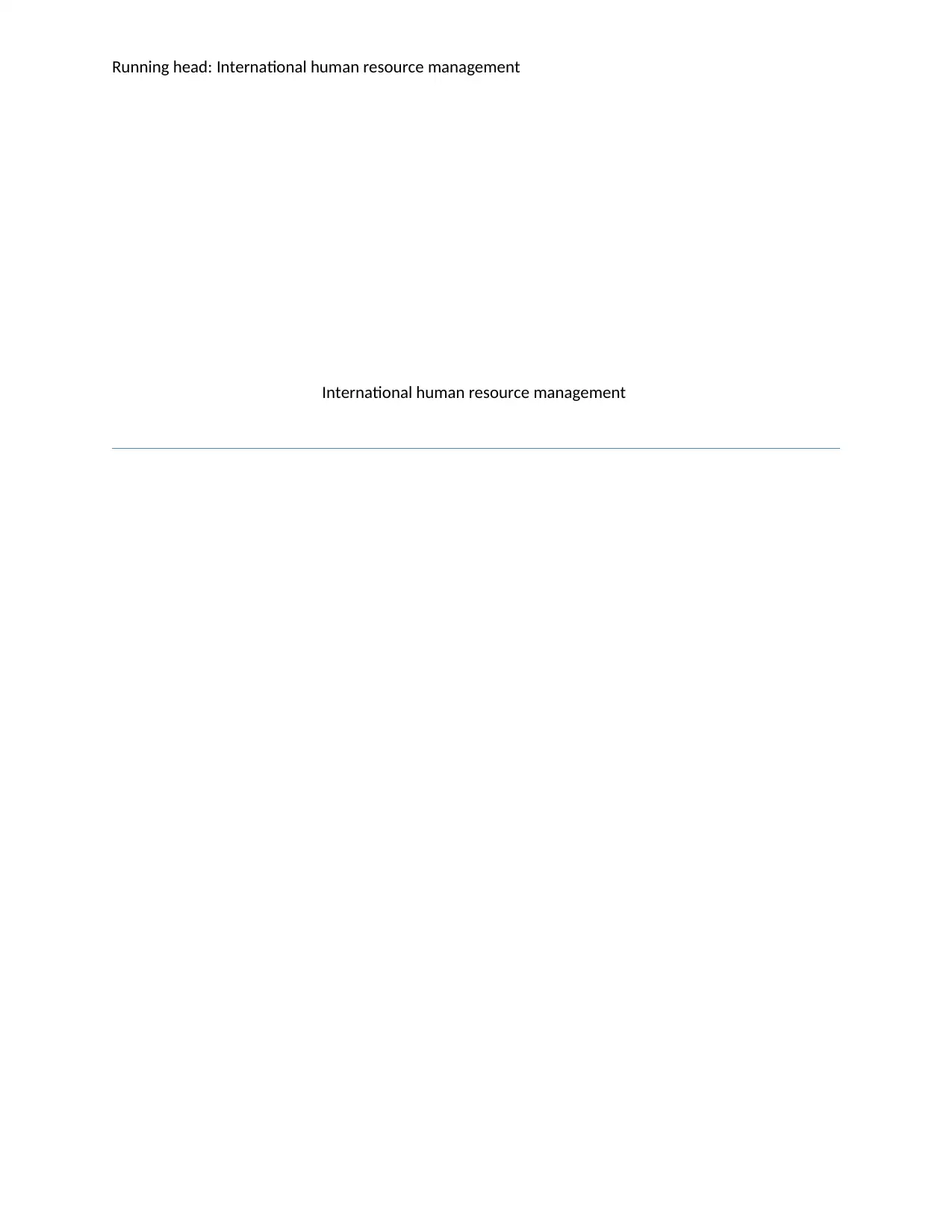
Running head: International human resource management
International human resource management
International human resource management
Paraphrase This Document
Need a fresh take? Get an instant paraphrase of this document with our AI Paraphraser
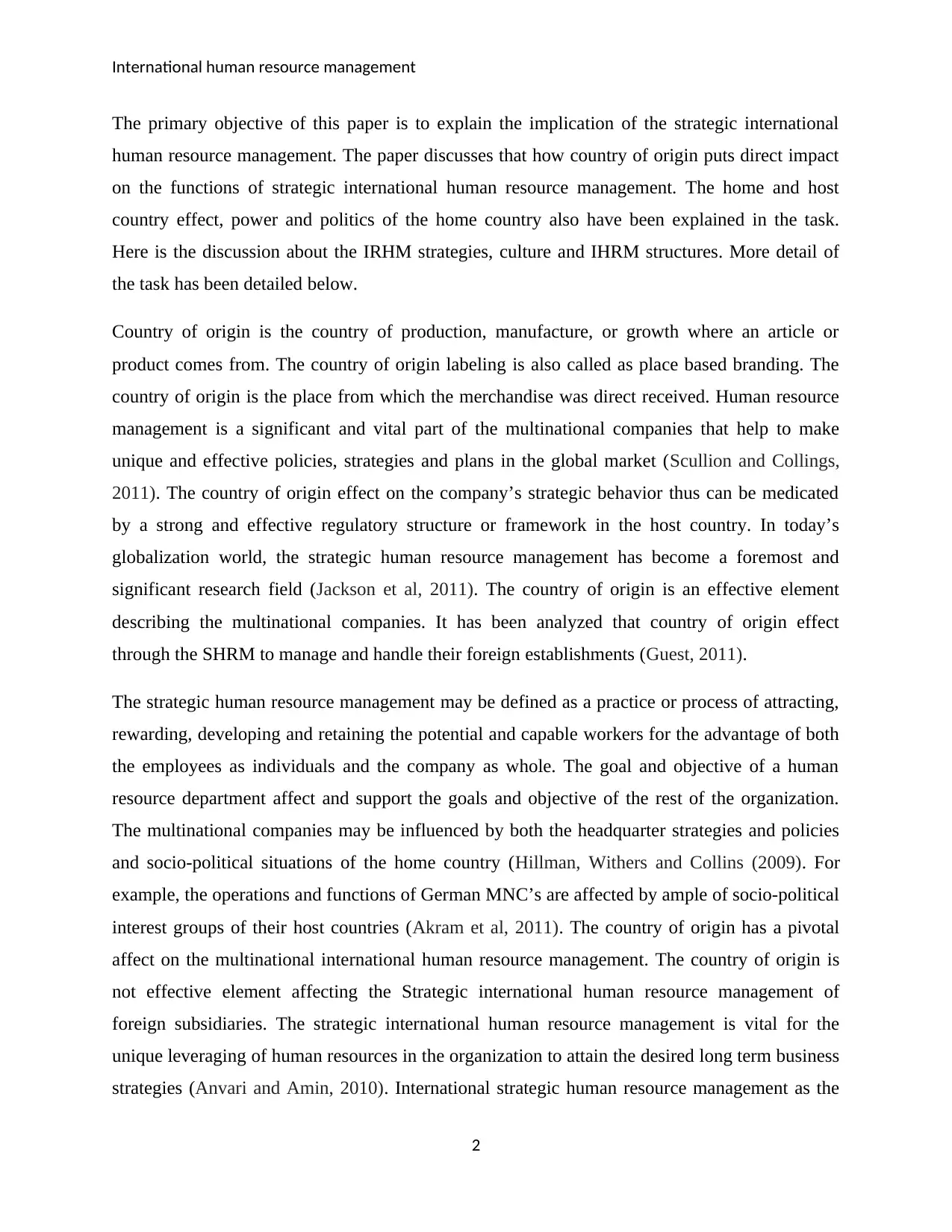
International human resource management
The primary objective of this paper is to explain the implication of the strategic international
human resource management. The paper discusses that how country of origin puts direct impact
on the functions of strategic international human resource management. The home and host
country effect, power and politics of the home country also have been explained in the task.
Here is the discussion about the IRHM strategies, culture and IHRM structures. More detail of
the task has been detailed below.
Country of origin is the country of production, manufacture, or growth where an article or
product comes from. The country of origin labeling is also called as place based branding. The
country of origin is the place from which the merchandise was direct received. Human resource
management is a significant and vital part of the multinational companies that help to make
unique and effective policies, strategies and plans in the global market (Scullion and Collings,
2011). The country of origin effect on the company’s strategic behavior thus can be medicated
by a strong and effective regulatory structure or framework in the host country. In today’s
globalization world, the strategic human resource management has become a foremost and
significant research field (Jackson et al, 2011). The country of origin is an effective element
describing the multinational companies. It has been analyzed that country of origin effect
through the SHRM to manage and handle their foreign establishments (Guest, 2011).
The strategic human resource management may be defined as a practice or process of attracting,
rewarding, developing and retaining the potential and capable workers for the advantage of both
the employees as individuals and the company as whole. The goal and objective of a human
resource department affect and support the goals and objective of the rest of the organization.
The multinational companies may be influenced by both the headquarter strategies and policies
and socio-political situations of the home country (Hillman, Withers and Collins (2009). For
example, the operations and functions of German MNC’s are affected by ample of socio-political
interest groups of their host countries (Akram et al, 2011). The country of origin has a pivotal
affect on the multinational international human resource management. The country of origin is
not effective element affecting the Strategic international human resource management of
foreign subsidiaries. The strategic international human resource management is vital for the
unique leveraging of human resources in the organization to attain the desired long term business
strategies (Anvari and Amin, 2010). International strategic human resource management as the
2
The primary objective of this paper is to explain the implication of the strategic international
human resource management. The paper discusses that how country of origin puts direct impact
on the functions of strategic international human resource management. The home and host
country effect, power and politics of the home country also have been explained in the task.
Here is the discussion about the IRHM strategies, culture and IHRM structures. More detail of
the task has been detailed below.
Country of origin is the country of production, manufacture, or growth where an article or
product comes from. The country of origin labeling is also called as place based branding. The
country of origin is the place from which the merchandise was direct received. Human resource
management is a significant and vital part of the multinational companies that help to make
unique and effective policies, strategies and plans in the global market (Scullion and Collings,
2011). The country of origin effect on the company’s strategic behavior thus can be medicated
by a strong and effective regulatory structure or framework in the host country. In today’s
globalization world, the strategic human resource management has become a foremost and
significant research field (Jackson et al, 2011). The country of origin is an effective element
describing the multinational companies. It has been analyzed that country of origin effect
through the SHRM to manage and handle their foreign establishments (Guest, 2011).
The strategic human resource management may be defined as a practice or process of attracting,
rewarding, developing and retaining the potential and capable workers for the advantage of both
the employees as individuals and the company as whole. The goal and objective of a human
resource department affect and support the goals and objective of the rest of the organization.
The multinational companies may be influenced by both the headquarter strategies and policies
and socio-political situations of the home country (Hillman, Withers and Collins (2009). For
example, the operations and functions of German MNC’s are affected by ample of socio-political
interest groups of their host countries (Akram et al, 2011). The country of origin has a pivotal
affect on the multinational international human resource management. The country of origin is
not effective element affecting the Strategic international human resource management of
foreign subsidiaries. The strategic international human resource management is vital for the
unique leveraging of human resources in the organization to attain the desired long term business
strategies (Anvari and Amin, 2010). International strategic human resource management as the
2
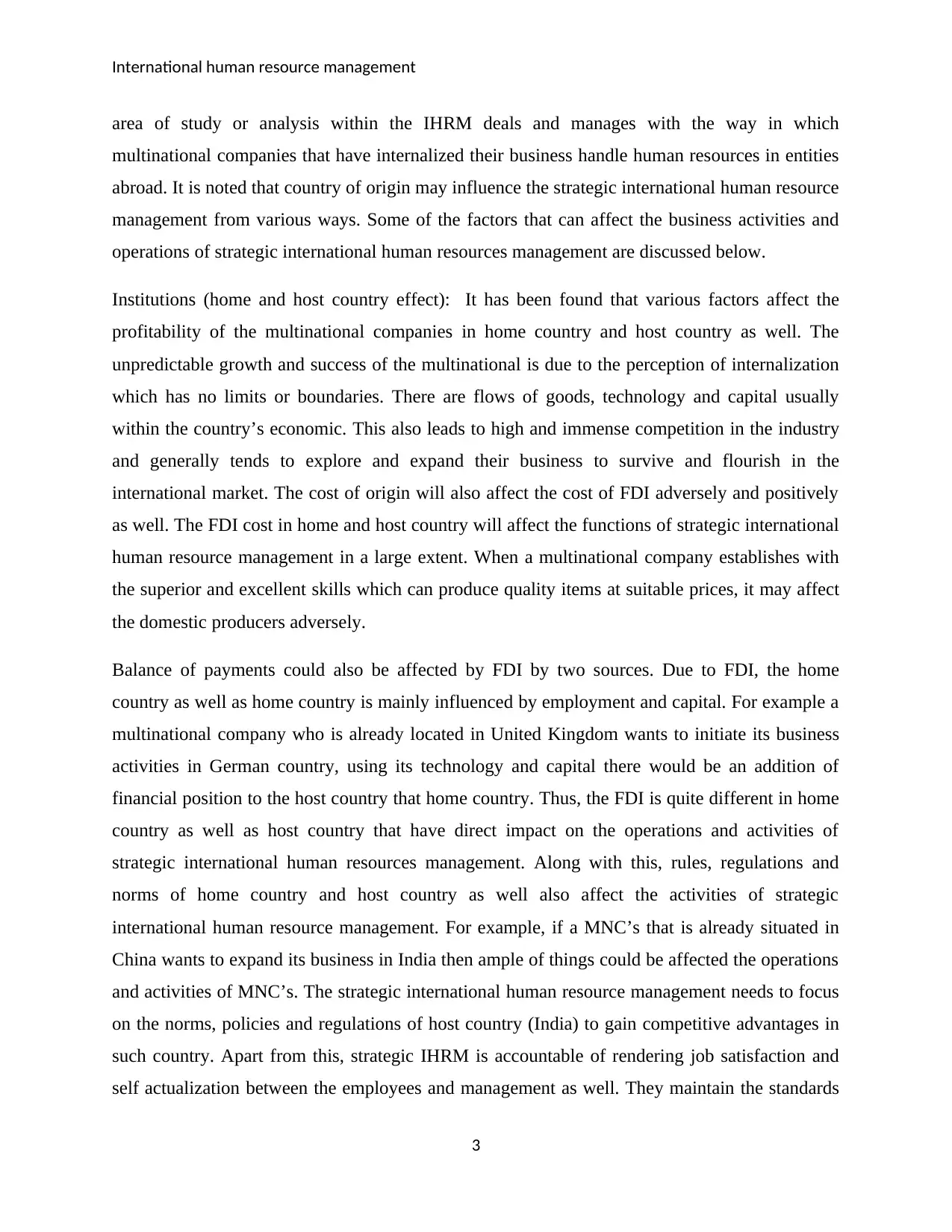
International human resource management
area of study or analysis within the IHRM deals and manages with the way in which
multinational companies that have internalized their business handle human resources in entities
abroad. It is noted that country of origin may influence the strategic international human resource
management from various ways. Some of the factors that can affect the business activities and
operations of strategic international human resources management are discussed below.
Institutions (home and host country effect): It has been found that various factors affect the
profitability of the multinational companies in home country and host country as well. The
unpredictable growth and success of the multinational is due to the perception of internalization
which has no limits or boundaries. There are flows of goods, technology and capital usually
within the country’s economic. This also leads to high and immense competition in the industry
and generally tends to explore and expand their business to survive and flourish in the
international market. The cost of origin will also affect the cost of FDI adversely and positively
as well. The FDI cost in home and host country will affect the functions of strategic international
human resource management in a large extent. When a multinational company establishes with
the superior and excellent skills which can produce quality items at suitable prices, it may affect
the domestic producers adversely.
Balance of payments could also be affected by FDI by two sources. Due to FDI, the home
country as well as home country is mainly influenced by employment and capital. For example a
multinational company who is already located in United Kingdom wants to initiate its business
activities in German country, using its technology and capital there would be an addition of
financial position to the host country that home country. Thus, the FDI is quite different in home
country as well as host country that have direct impact on the operations and activities of
strategic international human resources management. Along with this, rules, regulations and
norms of home country and host country as well also affect the activities of strategic
international human resource management. For example, if a MNC’s that is already situated in
China wants to expand its business in India then ample of things could be affected the operations
and activities of MNC’s. The strategic international human resource management needs to focus
on the norms, policies and regulations of host country (India) to gain competitive advantages in
such country. Apart from this, strategic IHRM is accountable of rendering job satisfaction and
self actualization between the employees and management as well. They maintain the standards
3
area of study or analysis within the IHRM deals and manages with the way in which
multinational companies that have internalized their business handle human resources in entities
abroad. It is noted that country of origin may influence the strategic international human resource
management from various ways. Some of the factors that can affect the business activities and
operations of strategic international human resources management are discussed below.
Institutions (home and host country effect): It has been found that various factors affect the
profitability of the multinational companies in home country and host country as well. The
unpredictable growth and success of the multinational is due to the perception of internalization
which has no limits or boundaries. There are flows of goods, technology and capital usually
within the country’s economic. This also leads to high and immense competition in the industry
and generally tends to explore and expand their business to survive and flourish in the
international market. The cost of origin will also affect the cost of FDI adversely and positively
as well. The FDI cost in home and host country will affect the functions of strategic international
human resource management in a large extent. When a multinational company establishes with
the superior and excellent skills which can produce quality items at suitable prices, it may affect
the domestic producers adversely.
Balance of payments could also be affected by FDI by two sources. Due to FDI, the home
country as well as home country is mainly influenced by employment and capital. For example a
multinational company who is already located in United Kingdom wants to initiate its business
activities in German country, using its technology and capital there would be an addition of
financial position to the host country that home country. Thus, the FDI is quite different in home
country as well as host country that have direct impact on the operations and activities of
strategic international human resources management. Along with this, rules, regulations and
norms of home country and host country as well also affect the activities of strategic
international human resource management. For example, if a MNC’s that is already situated in
China wants to expand its business in India then ample of things could be affected the operations
and activities of MNC’s. The strategic international human resource management needs to focus
on the norms, policies and regulations of host country (India) to gain competitive advantages in
such country. Apart from this, strategic IHRM is accountable of rendering job satisfaction and
self actualization between the employees and management as well. They maintain the standards
3
⊘ This is a preview!⊘
Do you want full access?
Subscribe today to unlock all pages.

Trusted by 1+ million students worldwide
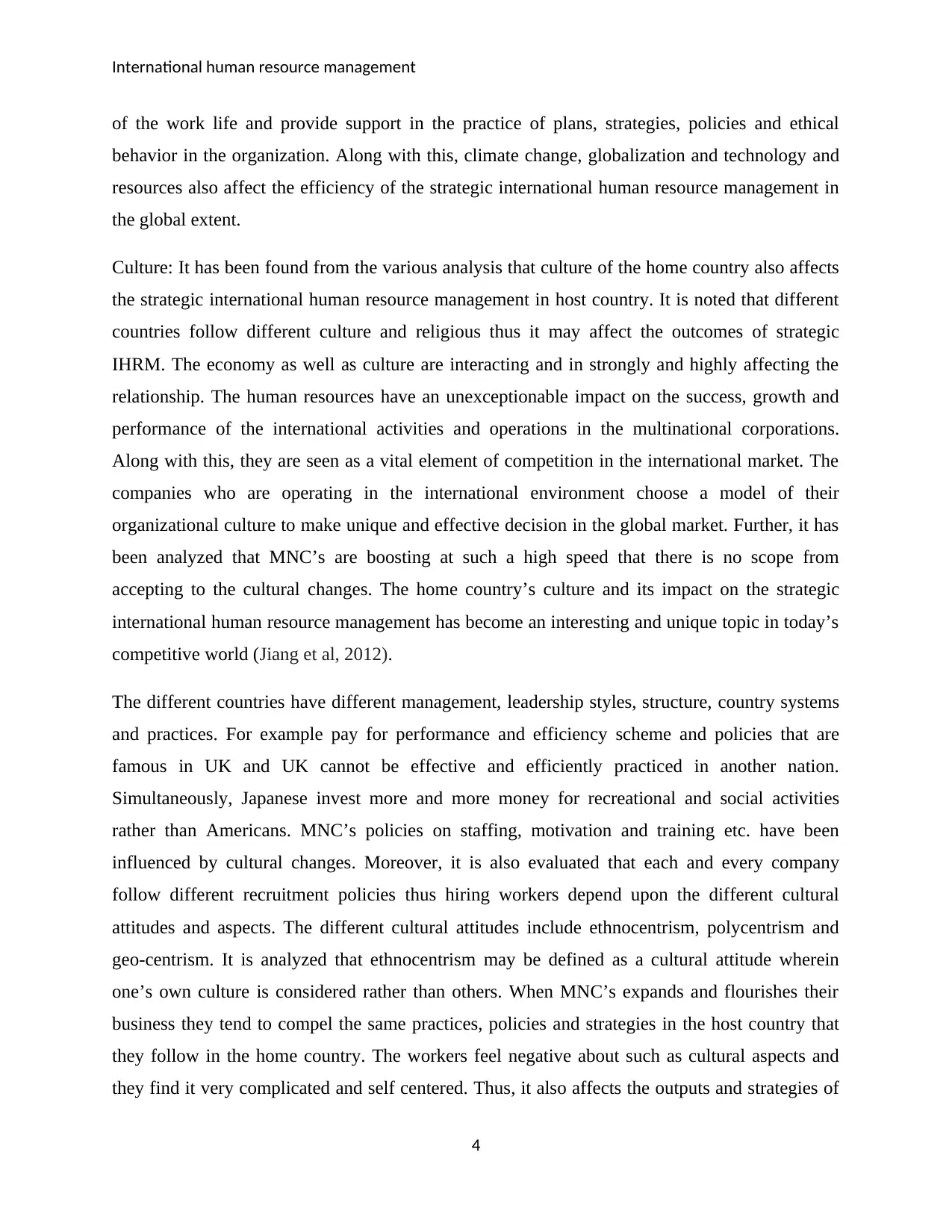
International human resource management
of the work life and provide support in the practice of plans, strategies, policies and ethical
behavior in the organization. Along with this, climate change, globalization and technology and
resources also affect the efficiency of the strategic international human resource management in
the global extent.
Culture: It has been found from the various analysis that culture of the home country also affects
the strategic international human resource management in host country. It is noted that different
countries follow different culture and religious thus it may affect the outcomes of strategic
IHRM. The economy as well as culture are interacting and in strongly and highly affecting the
relationship. The human resources have an unexceptionable impact on the success, growth and
performance of the international activities and operations in the multinational corporations.
Along with this, they are seen as a vital element of competition in the international market. The
companies who are operating in the international environment choose a model of their
organizational culture to make unique and effective decision in the global market. Further, it has
been analyzed that MNC’s are boosting at such a high speed that there is no scope from
accepting to the cultural changes. The home country’s culture and its impact on the strategic
international human resource management has become an interesting and unique topic in today’s
competitive world (Jiang et al, 2012).
The different countries have different management, leadership styles, structure, country systems
and practices. For example pay for performance and efficiency scheme and policies that are
famous in UK and UK cannot be effective and efficiently practiced in another nation.
Simultaneously, Japanese invest more and more money for recreational and social activities
rather than Americans. MNC’s policies on staffing, motivation and training etc. have been
influenced by cultural changes. Moreover, it is also evaluated that each and every company
follow different recruitment policies thus hiring workers depend upon the different cultural
attitudes and aspects. The different cultural attitudes include ethnocentrism, polycentrism and
geo-centrism. It is analyzed that ethnocentrism may be defined as a cultural attitude wherein
one’s own culture is considered rather than others. When MNC’s expands and flourishes their
business they tend to compel the same practices, policies and strategies in the host country that
they follow in the home country. The workers feel negative about such as cultural aspects and
they find it very complicated and self centered. Thus, it also affects the outputs and strategies of
4
of the work life and provide support in the practice of plans, strategies, policies and ethical
behavior in the organization. Along with this, climate change, globalization and technology and
resources also affect the efficiency of the strategic international human resource management in
the global extent.
Culture: It has been found from the various analysis that culture of the home country also affects
the strategic international human resource management in host country. It is noted that different
countries follow different culture and religious thus it may affect the outcomes of strategic
IHRM. The economy as well as culture are interacting and in strongly and highly affecting the
relationship. The human resources have an unexceptionable impact on the success, growth and
performance of the international activities and operations in the multinational corporations.
Along with this, they are seen as a vital element of competition in the international market. The
companies who are operating in the international environment choose a model of their
organizational culture to make unique and effective decision in the global market. Further, it has
been analyzed that MNC’s are boosting at such a high speed that there is no scope from
accepting to the cultural changes. The home country’s culture and its impact on the strategic
international human resource management has become an interesting and unique topic in today’s
competitive world (Jiang et al, 2012).
The different countries have different management, leadership styles, structure, country systems
and practices. For example pay for performance and efficiency scheme and policies that are
famous in UK and UK cannot be effective and efficiently practiced in another nation.
Simultaneously, Japanese invest more and more money for recreational and social activities
rather than Americans. MNC’s policies on staffing, motivation and training etc. have been
influenced by cultural changes. Moreover, it is also evaluated that each and every company
follow different recruitment policies thus hiring workers depend upon the different cultural
attitudes and aspects. The different cultural attitudes include ethnocentrism, polycentrism and
geo-centrism. It is analyzed that ethnocentrism may be defined as a cultural attitude wherein
one’s own culture is considered rather than others. When MNC’s expands and flourishes their
business they tend to compel the same practices, policies and strategies in the host country that
they follow in the home country. The workers feel negative about such as cultural aspects and
they find it very complicated and self centered. Thus, it also affects the outputs and strategies of
4
Paraphrase This Document
Need a fresh take? Get an instant paraphrase of this document with our AI Paraphraser
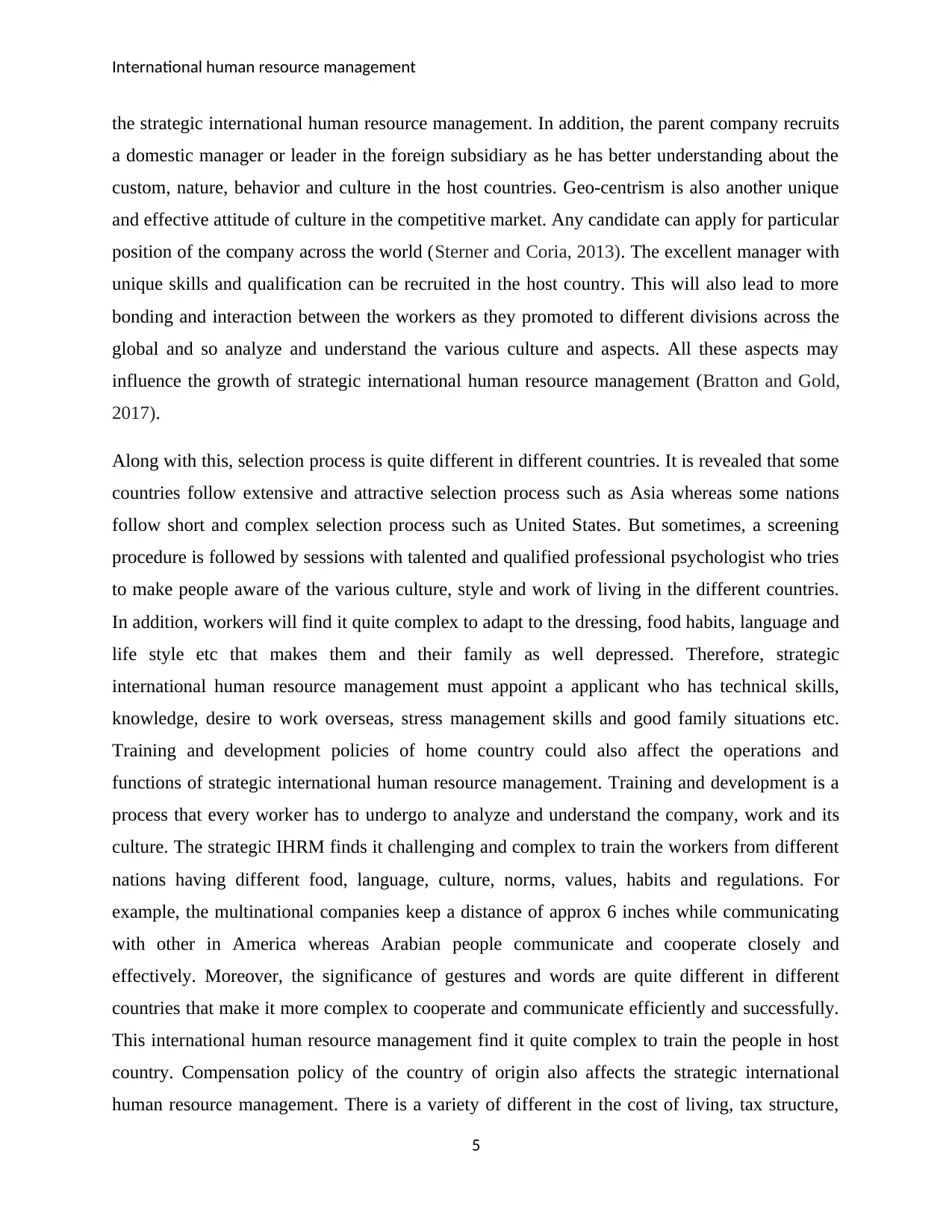
International human resource management
the strategic international human resource management. In addition, the parent company recruits
a domestic manager or leader in the foreign subsidiary as he has better understanding about the
custom, nature, behavior and culture in the host countries. Geo-centrism is also another unique
and effective attitude of culture in the competitive market. Any candidate can apply for particular
position of the company across the world (Sterner and Coria, 2013). The excellent manager with
unique skills and qualification can be recruited in the host country. This will also lead to more
bonding and interaction between the workers as they promoted to different divisions across the
global and so analyze and understand the various culture and aspects. All these aspects may
influence the growth of strategic international human resource management (Bratton and Gold,
2017).
Along with this, selection process is quite different in different countries. It is revealed that some
countries follow extensive and attractive selection process such as Asia whereas some nations
follow short and complex selection process such as United States. But sometimes, a screening
procedure is followed by sessions with talented and qualified professional psychologist who tries
to make people aware of the various culture, style and work of living in the different countries.
In addition, workers will find it quite complex to adapt to the dressing, food habits, language and
life style etc that makes them and their family as well depressed. Therefore, strategic
international human resource management must appoint a applicant who has technical skills,
knowledge, desire to work overseas, stress management skills and good family situations etc.
Training and development policies of home country could also affect the operations and
functions of strategic international human resource management. Training and development is a
process that every worker has to undergo to analyze and understand the company, work and its
culture. The strategic IHRM finds it challenging and complex to train the workers from different
nations having different food, language, culture, norms, values, habits and regulations. For
example, the multinational companies keep a distance of approx 6 inches while communicating
with other in America whereas Arabian people communicate and cooperate closely and
effectively. Moreover, the significance of gestures and words are quite different in different
countries that make it more complex to cooperate and communicate efficiently and successfully.
This international human resource management find it quite complex to train the people in host
country. Compensation policy of the country of origin also affects the strategic international
human resource management. There is a variety of different in the cost of living, tax structure,
5
the strategic international human resource management. In addition, the parent company recruits
a domestic manager or leader in the foreign subsidiary as he has better understanding about the
custom, nature, behavior and culture in the host countries. Geo-centrism is also another unique
and effective attitude of culture in the competitive market. Any candidate can apply for particular
position of the company across the world (Sterner and Coria, 2013). The excellent manager with
unique skills and qualification can be recruited in the host country. This will also lead to more
bonding and interaction between the workers as they promoted to different divisions across the
global and so analyze and understand the various culture and aspects. All these aspects may
influence the growth of strategic international human resource management (Bratton and Gold,
2017).
Along with this, selection process is quite different in different countries. It is revealed that some
countries follow extensive and attractive selection process such as Asia whereas some nations
follow short and complex selection process such as United States. But sometimes, a screening
procedure is followed by sessions with talented and qualified professional psychologist who tries
to make people aware of the various culture, style and work of living in the different countries.
In addition, workers will find it quite complex to adapt to the dressing, food habits, language and
life style etc that makes them and their family as well depressed. Therefore, strategic
international human resource management must appoint a applicant who has technical skills,
knowledge, desire to work overseas, stress management skills and good family situations etc.
Training and development policies of home country could also affect the operations and
functions of strategic international human resource management. Training and development is a
process that every worker has to undergo to analyze and understand the company, work and its
culture. The strategic IHRM finds it challenging and complex to train the workers from different
nations having different food, language, culture, norms, values, habits and regulations. For
example, the multinational companies keep a distance of approx 6 inches while communicating
with other in America whereas Arabian people communicate and cooperate closely and
effectively. Moreover, the significance of gestures and words are quite different in different
countries that make it more complex to cooperate and communicate efficiently and successfully.
This international human resource management find it quite complex to train the people in host
country. Compensation policy of the country of origin also affects the strategic international
human resource management. There is a variety of different in the cost of living, tax structure,
5
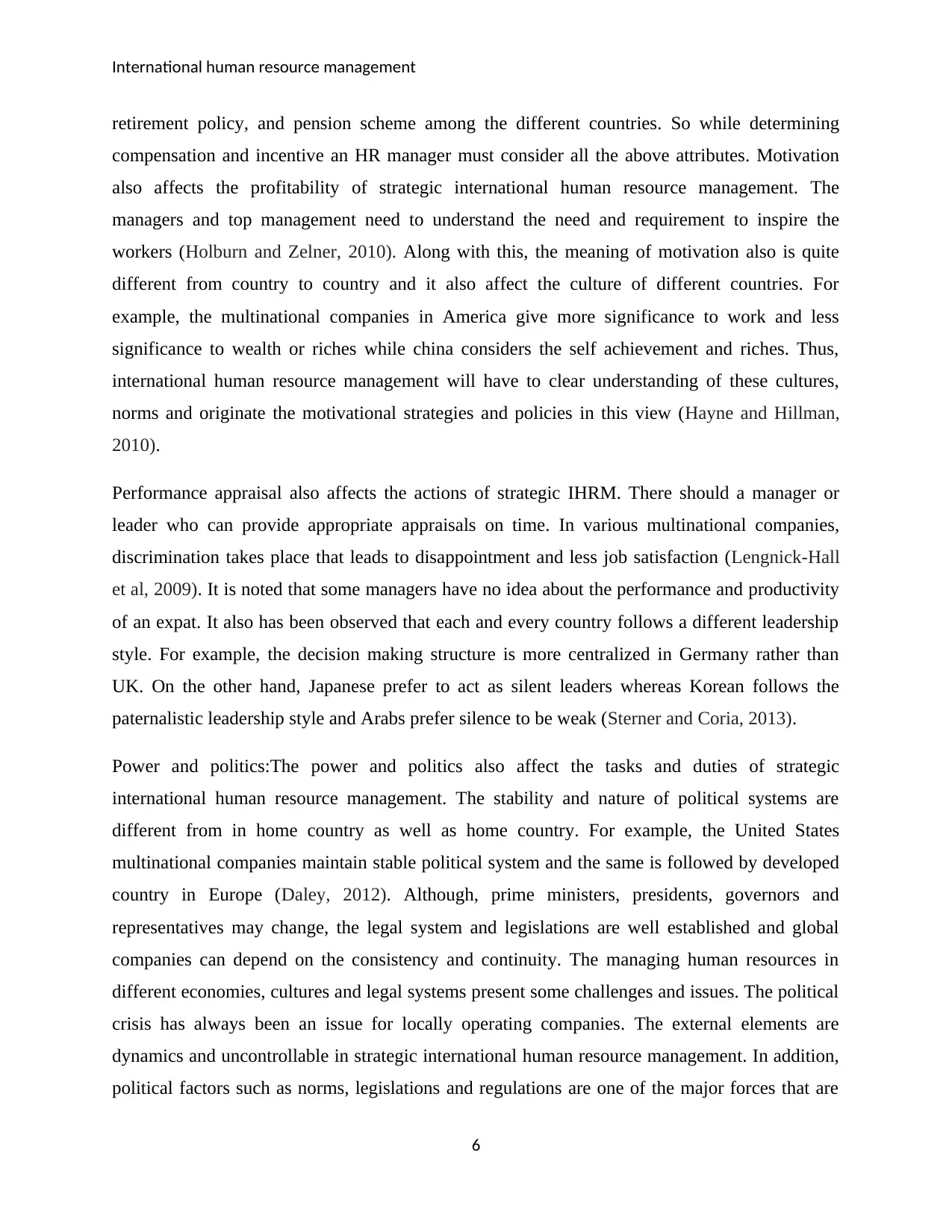
International human resource management
retirement policy, and pension scheme among the different countries. So while determining
compensation and incentive an HR manager must consider all the above attributes. Motivation
also affects the profitability of strategic international human resource management. The
managers and top management need to understand the need and requirement to inspire the
workers (Holburn and Zelner, 2010). Along with this, the meaning of motivation also is quite
different from country to country and it also affect the culture of different countries. For
example, the multinational companies in America give more significance to work and less
significance to wealth or riches while china considers the self achievement and riches. Thus,
international human resource management will have to clear understanding of these cultures,
norms and originate the motivational strategies and policies in this view (Hayne and Hillman,
2010).
Performance appraisal also affects the actions of strategic IHRM. There should a manager or
leader who can provide appropriate appraisals on time. In various multinational companies,
discrimination takes place that leads to disappointment and less job satisfaction (Lengnick-Hall
et al, 2009). It is noted that some managers have no idea about the performance and productivity
of an expat. It also has been observed that each and every country follows a different leadership
style. For example, the decision making structure is more centralized in Germany rather than
UK. On the other hand, Japanese prefer to act as silent leaders whereas Korean follows the
paternalistic leadership style and Arabs prefer silence to be weak (Sterner and Coria, 2013).
Power and politics:The power and politics also affect the tasks and duties of strategic
international human resource management. The stability and nature of political systems are
different from in home country as well as home country. For example, the United States
multinational companies maintain stable political system and the same is followed by developed
country in Europe (Daley, 2012). Although, prime ministers, presidents, governors and
representatives may change, the legal system and legislations are well established and global
companies can depend on the consistency and continuity. The managing human resources in
different economies, cultures and legal systems present some challenges and issues. The political
crisis has always been an issue for locally operating companies. The external elements are
dynamics and uncontrollable in strategic international human resource management. In addition,
political factors such as norms, legislations and regulations are one of the major forces that are
6
retirement policy, and pension scheme among the different countries. So while determining
compensation and incentive an HR manager must consider all the above attributes. Motivation
also affects the profitability of strategic international human resource management. The
managers and top management need to understand the need and requirement to inspire the
workers (Holburn and Zelner, 2010). Along with this, the meaning of motivation also is quite
different from country to country and it also affect the culture of different countries. For
example, the multinational companies in America give more significance to work and less
significance to wealth or riches while china considers the self achievement and riches. Thus,
international human resource management will have to clear understanding of these cultures,
norms and originate the motivational strategies and policies in this view (Hayne and Hillman,
2010).
Performance appraisal also affects the actions of strategic IHRM. There should a manager or
leader who can provide appropriate appraisals on time. In various multinational companies,
discrimination takes place that leads to disappointment and less job satisfaction (Lengnick-Hall
et al, 2009). It is noted that some managers have no idea about the performance and productivity
of an expat. It also has been observed that each and every country follows a different leadership
style. For example, the decision making structure is more centralized in Germany rather than
UK. On the other hand, Japanese prefer to act as silent leaders whereas Korean follows the
paternalistic leadership style and Arabs prefer silence to be weak (Sterner and Coria, 2013).
Power and politics:The power and politics also affect the tasks and duties of strategic
international human resource management. The stability and nature of political systems are
different from in home country as well as home country. For example, the United States
multinational companies maintain stable political system and the same is followed by developed
country in Europe (Daley, 2012). Although, prime ministers, presidents, governors and
representatives may change, the legal system and legislations are well established and global
companies can depend on the consistency and continuity. The managing human resources in
different economies, cultures and legal systems present some challenges and issues. The political
crisis has always been an issue for locally operating companies. The external elements are
dynamics and uncontrollable in strategic international human resource management. In addition,
political factors such as norms, legislations and regulations are one of the major forces that are
6
⊘ This is a preview!⊘
Do you want full access?
Subscribe today to unlock all pages.

Trusted by 1+ million students worldwide
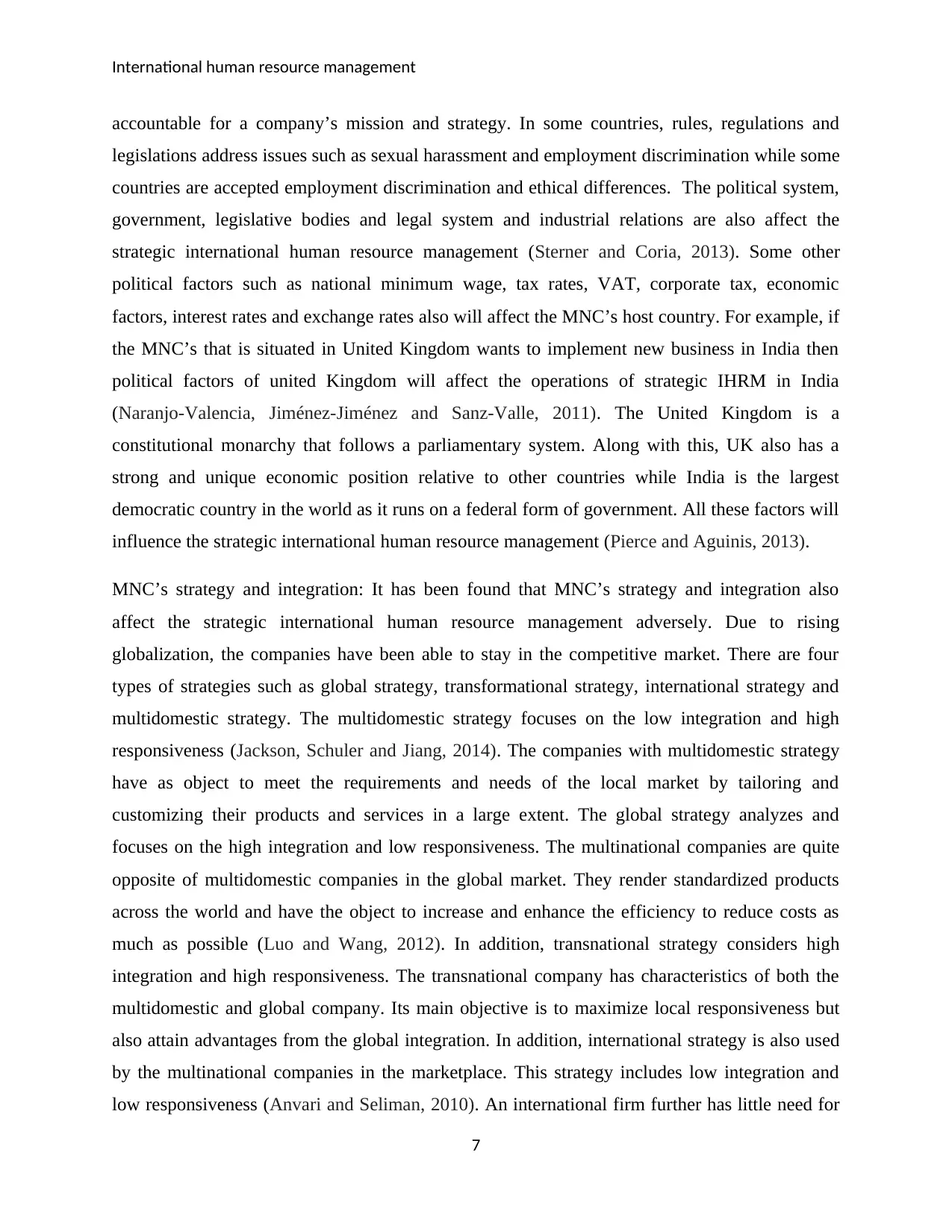
International human resource management
accountable for a company’s mission and strategy. In some countries, rules, regulations and
legislations address issues such as sexual harassment and employment discrimination while some
countries are accepted employment discrimination and ethical differences. The political system,
government, legislative bodies and legal system and industrial relations are also affect the
strategic international human resource management (Sterner and Coria, 2013). Some other
political factors such as national minimum wage, tax rates, VAT, corporate tax, economic
factors, interest rates and exchange rates also will affect the MNC’s host country. For example, if
the MNC’s that is situated in United Kingdom wants to implement new business in India then
political factors of united Kingdom will affect the operations of strategic IHRM in India
(Naranjo-Valencia, Jiménez-Jiménez and Sanz-Valle, 2011). The United Kingdom is a
constitutional monarchy that follows a parliamentary system. Along with this, UK also has a
strong and unique economic position relative to other countries while India is the largest
democratic country in the world as it runs on a federal form of government. All these factors will
influence the strategic international human resource management (Pierce and Aguinis, 2013).
MNC’s strategy and integration: It has been found that MNC’s strategy and integration also
affect the strategic international human resource management adversely. Due to rising
globalization, the companies have been able to stay in the competitive market. There are four
types of strategies such as global strategy, transformational strategy, international strategy and
multidomestic strategy. The multidomestic strategy focuses on the low integration and high
responsiveness (Jackson, Schuler and Jiang, 2014). The companies with multidomestic strategy
have as object to meet the requirements and needs of the local market by tailoring and
customizing their products and services in a large extent. The global strategy analyzes and
focuses on the high integration and low responsiveness. The multinational companies are quite
opposite of multidomestic companies in the global market. They render standardized products
across the world and have the object to increase and enhance the efficiency to reduce costs as
much as possible (Luo and Wang, 2012). In addition, transnational strategy considers high
integration and high responsiveness. The transnational company has characteristics of both the
multidomestic and global company. Its main objective is to maximize local responsiveness but
also attain advantages from the global integration. In addition, international strategy is also used
by the multinational companies in the marketplace. This strategy includes low integration and
low responsiveness (Anvari and Seliman, 2010). An international firm further has little need for
7
accountable for a company’s mission and strategy. In some countries, rules, regulations and
legislations address issues such as sexual harassment and employment discrimination while some
countries are accepted employment discrimination and ethical differences. The political system,
government, legislative bodies and legal system and industrial relations are also affect the
strategic international human resource management (Sterner and Coria, 2013). Some other
political factors such as national minimum wage, tax rates, VAT, corporate tax, economic
factors, interest rates and exchange rates also will affect the MNC’s host country. For example, if
the MNC’s that is situated in United Kingdom wants to implement new business in India then
political factors of united Kingdom will affect the operations of strategic IHRM in India
(Naranjo-Valencia, Jiménez-Jiménez and Sanz-Valle, 2011). The United Kingdom is a
constitutional monarchy that follows a parliamentary system. Along with this, UK also has a
strong and unique economic position relative to other countries while India is the largest
democratic country in the world as it runs on a federal form of government. All these factors will
influence the strategic international human resource management (Pierce and Aguinis, 2013).
MNC’s strategy and integration: It has been found that MNC’s strategy and integration also
affect the strategic international human resource management adversely. Due to rising
globalization, the companies have been able to stay in the competitive market. There are four
types of strategies such as global strategy, transformational strategy, international strategy and
multidomestic strategy. The multidomestic strategy focuses on the low integration and high
responsiveness (Jackson, Schuler and Jiang, 2014). The companies with multidomestic strategy
have as object to meet the requirements and needs of the local market by tailoring and
customizing their products and services in a large extent. The global strategy analyzes and
focuses on the high integration and low responsiveness. The multinational companies are quite
opposite of multidomestic companies in the global market. They render standardized products
across the world and have the object to increase and enhance the efficiency to reduce costs as
much as possible (Luo and Wang, 2012). In addition, transnational strategy considers high
integration and high responsiveness. The transnational company has characteristics of both the
multidomestic and global company. Its main objective is to maximize local responsiveness but
also attain advantages from the global integration. In addition, international strategy is also used
by the multinational companies in the marketplace. This strategy includes low integration and
low responsiveness (Anvari and Seliman, 2010). An international firm further has little need for
7
Paraphrase This Document
Need a fresh take? Get an instant paraphrase of this document with our AI Paraphraser
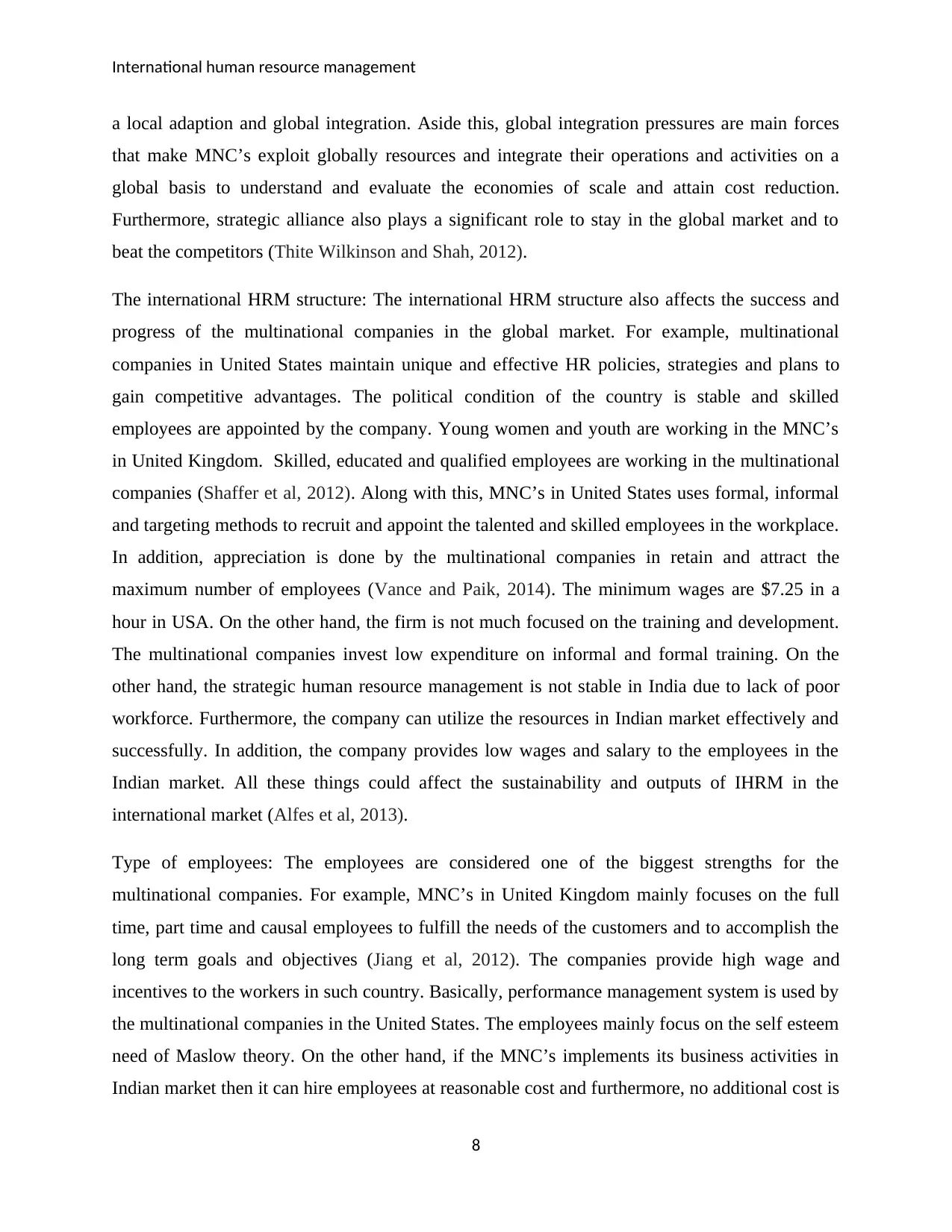
International human resource management
a local adaption and global integration. Aside this, global integration pressures are main forces
that make MNC’s exploit globally resources and integrate their operations and activities on a
global basis to understand and evaluate the economies of scale and attain cost reduction.
Furthermore, strategic alliance also plays a significant role to stay in the global market and to
beat the competitors (Thite Wilkinson and Shah, 2012).
The international HRM structure: The international HRM structure also affects the success and
progress of the multinational companies in the global market. For example, multinational
companies in United States maintain unique and effective HR policies, strategies and plans to
gain competitive advantages. The political condition of the country is stable and skilled
employees are appointed by the company. Young women and youth are working in the MNC’s
in United Kingdom. Skilled, educated and qualified employees are working in the multinational
companies (Shaffer et al, 2012). Along with this, MNC’s in United States uses formal, informal
and targeting methods to recruit and appoint the talented and skilled employees in the workplace.
In addition, appreciation is done by the multinational companies in retain and attract the
maximum number of employees (Vance and Paik, 2014). The minimum wages are $7.25 in a
hour in USA. On the other hand, the firm is not much focused on the training and development.
The multinational companies invest low expenditure on informal and formal training. On the
other hand, the strategic human resource management is not stable in India due to lack of poor
workforce. Furthermore, the company can utilize the resources in Indian market effectively and
successfully. In addition, the company provides low wages and salary to the employees in the
Indian market. All these things could affect the sustainability and outputs of IHRM in the
international market (Alfes et al, 2013).
Type of employees: The employees are considered one of the biggest strengths for the
multinational companies. For example, MNC’s in United Kingdom mainly focuses on the full
time, part time and causal employees to fulfill the needs of the customers and to accomplish the
long term goals and objectives (Jiang et al, 2012). The companies provide high wage and
incentives to the workers in such country. Basically, performance management system is used by
the multinational companies in the United States. The employees mainly focus on the self esteem
need of Maslow theory. On the other hand, if the MNC’s implements its business activities in
Indian market then it can hire employees at reasonable cost and furthermore, no additional cost is
8
a local adaption and global integration. Aside this, global integration pressures are main forces
that make MNC’s exploit globally resources and integrate their operations and activities on a
global basis to understand and evaluate the economies of scale and attain cost reduction.
Furthermore, strategic alliance also plays a significant role to stay in the global market and to
beat the competitors (Thite Wilkinson and Shah, 2012).
The international HRM structure: The international HRM structure also affects the success and
progress of the multinational companies in the global market. For example, multinational
companies in United States maintain unique and effective HR policies, strategies and plans to
gain competitive advantages. The political condition of the country is stable and skilled
employees are appointed by the company. Young women and youth are working in the MNC’s
in United Kingdom. Skilled, educated and qualified employees are working in the multinational
companies (Shaffer et al, 2012). Along with this, MNC’s in United States uses formal, informal
and targeting methods to recruit and appoint the talented and skilled employees in the workplace.
In addition, appreciation is done by the multinational companies in retain and attract the
maximum number of employees (Vance and Paik, 2014). The minimum wages are $7.25 in a
hour in USA. On the other hand, the firm is not much focused on the training and development.
The multinational companies invest low expenditure on informal and formal training. On the
other hand, the strategic human resource management is not stable in India due to lack of poor
workforce. Furthermore, the company can utilize the resources in Indian market effectively and
successfully. In addition, the company provides low wages and salary to the employees in the
Indian market. All these things could affect the sustainability and outputs of IHRM in the
international market (Alfes et al, 2013).
Type of employees: The employees are considered one of the biggest strengths for the
multinational companies. For example, MNC’s in United Kingdom mainly focuses on the full
time, part time and causal employees to fulfill the needs of the customers and to accomplish the
long term goals and objectives (Jiang et al, 2012). The companies provide high wage and
incentives to the workers in such country. Basically, performance management system is used by
the multinational companies in the United States. The employees mainly focus on the self esteem
need of Maslow theory. On the other hand, if the MNC’s implements its business activities in
Indian market then it can hire employees at reasonable cost and furthermore, no additional cost is
8
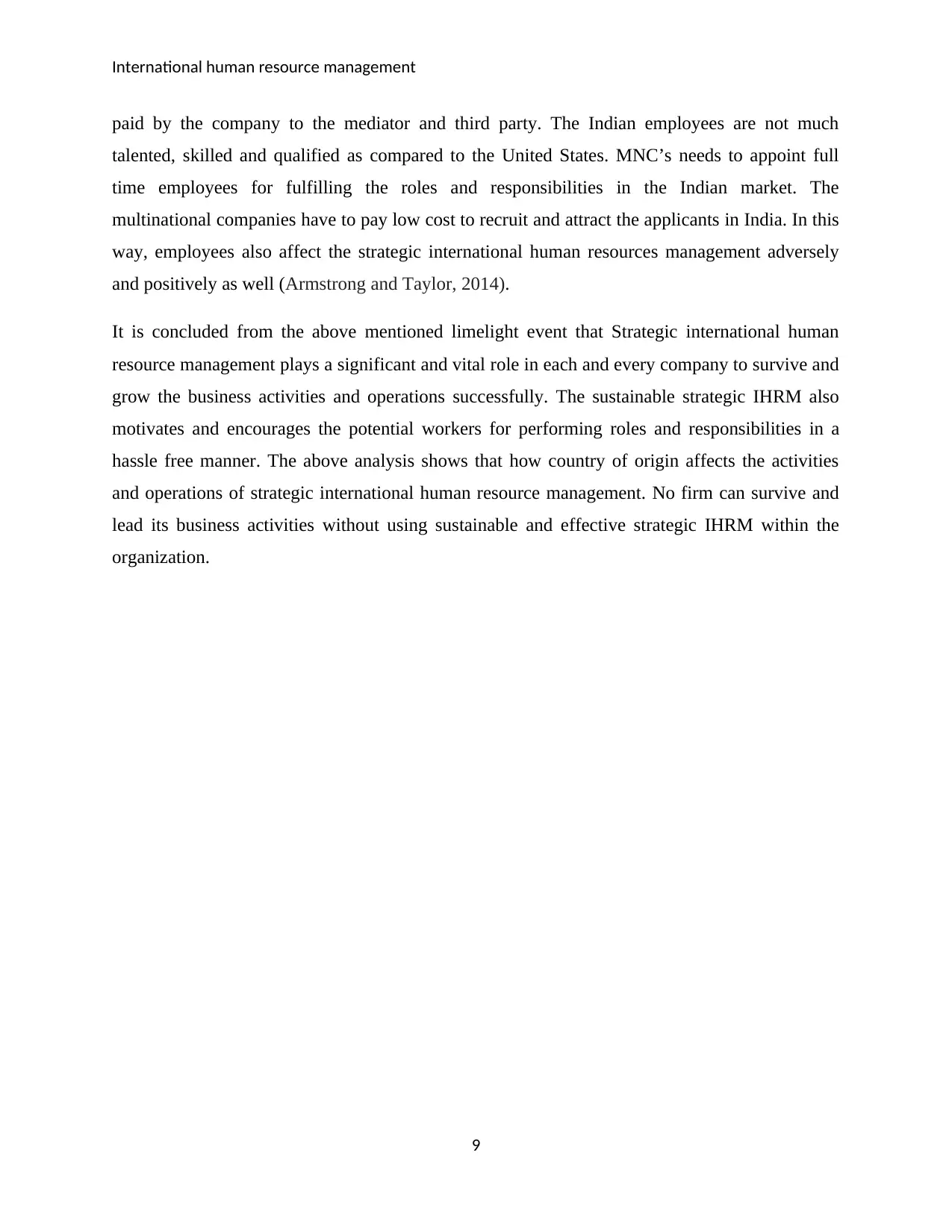
International human resource management
paid by the company to the mediator and third party. The Indian employees are not much
talented, skilled and qualified as compared to the United States. MNC’s needs to appoint full
time employees for fulfilling the roles and responsibilities in the Indian market. The
multinational companies have to pay low cost to recruit and attract the applicants in India. In this
way, employees also affect the strategic international human resources management adversely
and positively as well (Armstrong and Taylor, 2014).
It is concluded from the above mentioned limelight event that Strategic international human
resource management plays a significant and vital role in each and every company to survive and
grow the business activities and operations successfully. The sustainable strategic IHRM also
motivates and encourages the potential workers for performing roles and responsibilities in a
hassle free manner. The above analysis shows that how country of origin affects the activities
and operations of strategic international human resource management. No firm can survive and
lead its business activities without using sustainable and effective strategic IHRM within the
organization.
9
paid by the company to the mediator and third party. The Indian employees are not much
talented, skilled and qualified as compared to the United States. MNC’s needs to appoint full
time employees for fulfilling the roles and responsibilities in the Indian market. The
multinational companies have to pay low cost to recruit and attract the applicants in India. In this
way, employees also affect the strategic international human resources management adversely
and positively as well (Armstrong and Taylor, 2014).
It is concluded from the above mentioned limelight event that Strategic international human
resource management plays a significant and vital role in each and every company to survive and
grow the business activities and operations successfully. The sustainable strategic IHRM also
motivates and encourages the potential workers for performing roles and responsibilities in a
hassle free manner. The above analysis shows that how country of origin affects the activities
and operations of strategic international human resource management. No firm can survive and
lead its business activities without using sustainable and effective strategic IHRM within the
organization.
9
⊘ This is a preview!⊘
Do you want full access?
Subscribe today to unlock all pages.

Trusted by 1+ million students worldwide
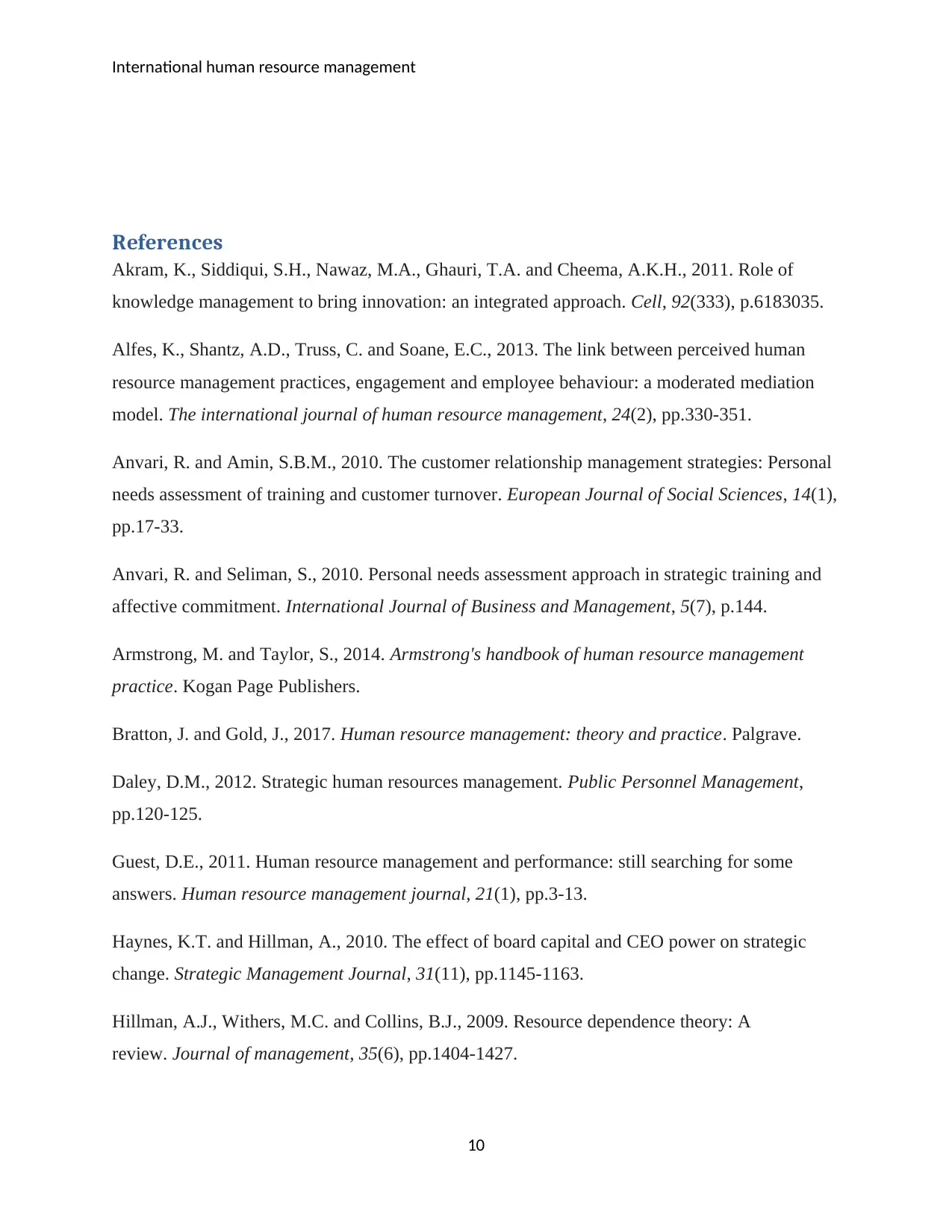
International human resource management
References
Akram, K., Siddiqui, S.H., Nawaz, M.A., Ghauri, T.A. and Cheema, A.K.H., 2011. Role of
knowledge management to bring innovation: an integrated approach. Cell, 92(333), p.6183035.
Alfes, K., Shantz, A.D., Truss, C. and Soane, E.C., 2013. The link between perceived human
resource management practices, engagement and employee behaviour: a moderated mediation
model. The international journal of human resource management, 24(2), pp.330-351.
Anvari, R. and Amin, S.B.M., 2010. The customer relationship management strategies: Personal
needs assessment of training and customer turnover. European Journal of Social Sciences, 14(1),
pp.17-33.
Anvari, R. and Seliman, S., 2010. Personal needs assessment approach in strategic training and
affective commitment. International Journal of Business and Management, 5(7), p.144.
Armstrong, M. and Taylor, S., 2014. Armstrong's handbook of human resource management
practice. Kogan Page Publishers.
Bratton, J. and Gold, J., 2017. Human resource management: theory and practice. Palgrave.
Daley, D.M., 2012. Strategic human resources management. Public Personnel Management,
pp.120-125.
Guest, D.E., 2011. Human resource management and performance: still searching for some
answers. Human resource management journal, 21(1), pp.3-13.
Haynes, K.T. and Hillman, A., 2010. The effect of board capital and CEO power on strategic
change. Strategic Management Journal, 31(11), pp.1145-1163.
Hillman, A.J., Withers, M.C. and Collins, B.J., 2009. Resource dependence theory: A
review. Journal of management, 35(6), pp.1404-1427.
10
References
Akram, K., Siddiqui, S.H., Nawaz, M.A., Ghauri, T.A. and Cheema, A.K.H., 2011. Role of
knowledge management to bring innovation: an integrated approach. Cell, 92(333), p.6183035.
Alfes, K., Shantz, A.D., Truss, C. and Soane, E.C., 2013. The link between perceived human
resource management practices, engagement and employee behaviour: a moderated mediation
model. The international journal of human resource management, 24(2), pp.330-351.
Anvari, R. and Amin, S.B.M., 2010. The customer relationship management strategies: Personal
needs assessment of training and customer turnover. European Journal of Social Sciences, 14(1),
pp.17-33.
Anvari, R. and Seliman, S., 2010. Personal needs assessment approach in strategic training and
affective commitment. International Journal of Business and Management, 5(7), p.144.
Armstrong, M. and Taylor, S., 2014. Armstrong's handbook of human resource management
practice. Kogan Page Publishers.
Bratton, J. and Gold, J., 2017. Human resource management: theory and practice. Palgrave.
Daley, D.M., 2012. Strategic human resources management. Public Personnel Management,
pp.120-125.
Guest, D.E., 2011. Human resource management and performance: still searching for some
answers. Human resource management journal, 21(1), pp.3-13.
Haynes, K.T. and Hillman, A., 2010. The effect of board capital and CEO power on strategic
change. Strategic Management Journal, 31(11), pp.1145-1163.
Hillman, A.J., Withers, M.C. and Collins, B.J., 2009. Resource dependence theory: A
review. Journal of management, 35(6), pp.1404-1427.
10
Paraphrase This Document
Need a fresh take? Get an instant paraphrase of this document with our AI Paraphraser
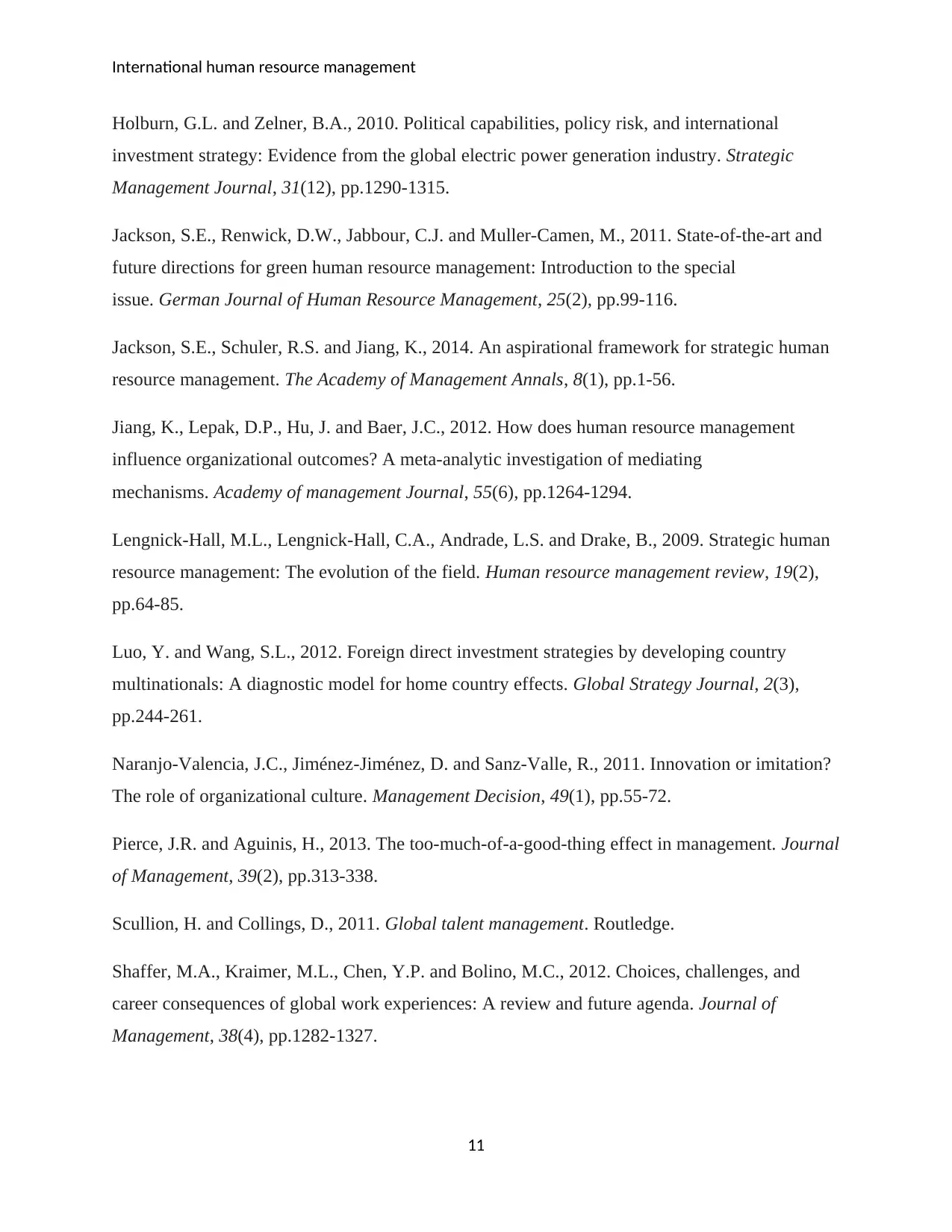
International human resource management
Holburn, G.L. and Zelner, B.A., 2010. Political capabilities, policy risk, and international
investment strategy: Evidence from the global electric power generation industry. Strategic
Management Journal, 31(12), pp.1290-1315.
Jackson, S.E., Renwick, D.W., Jabbour, C.J. and Muller-Camen, M., 2011. State-of-the-art and
future directions for green human resource management: Introduction to the special
issue. German Journal of Human Resource Management, 25(2), pp.99-116.
Jackson, S.E., Schuler, R.S. and Jiang, K., 2014. An aspirational framework for strategic human
resource management. The Academy of Management Annals, 8(1), pp.1-56.
Jiang, K., Lepak, D.P., Hu, J. and Baer, J.C., 2012. How does human resource management
influence organizational outcomes? A meta-analytic investigation of mediating
mechanisms. Academy of management Journal, 55(6), pp.1264-1294.
Lengnick-Hall, M.L., Lengnick-Hall, C.A., Andrade, L.S. and Drake, B., 2009. Strategic human
resource management: The evolution of the field. Human resource management review, 19(2),
pp.64-85.
Luo, Y. and Wang, S.L., 2012. Foreign direct investment strategies by developing country
multinationals: A diagnostic model for home country effects. Global Strategy Journal, 2(3),
pp.244-261.
Naranjo-Valencia, J.C., Jiménez-Jiménez, D. and Sanz-Valle, R., 2011. Innovation or imitation?
The role of organizational culture. Management Decision, 49(1), pp.55-72.
Pierce, J.R. and Aguinis, H., 2013. The too-much-of-a-good-thing effect in management. Journal
of Management, 39(2), pp.313-338.
Scullion, H. and Collings, D., 2011. Global talent management. Routledge.
Shaffer, M.A., Kraimer, M.L., Chen, Y.P. and Bolino, M.C., 2012. Choices, challenges, and
career consequences of global work experiences: A review and future agenda. Journal of
Management, 38(4), pp.1282-1327.
11
Holburn, G.L. and Zelner, B.A., 2010. Political capabilities, policy risk, and international
investment strategy: Evidence from the global electric power generation industry. Strategic
Management Journal, 31(12), pp.1290-1315.
Jackson, S.E., Renwick, D.W., Jabbour, C.J. and Muller-Camen, M., 2011. State-of-the-art and
future directions for green human resource management: Introduction to the special
issue. German Journal of Human Resource Management, 25(2), pp.99-116.
Jackson, S.E., Schuler, R.S. and Jiang, K., 2014. An aspirational framework for strategic human
resource management. The Academy of Management Annals, 8(1), pp.1-56.
Jiang, K., Lepak, D.P., Hu, J. and Baer, J.C., 2012. How does human resource management
influence organizational outcomes? A meta-analytic investigation of mediating
mechanisms. Academy of management Journal, 55(6), pp.1264-1294.
Lengnick-Hall, M.L., Lengnick-Hall, C.A., Andrade, L.S. and Drake, B., 2009. Strategic human
resource management: The evolution of the field. Human resource management review, 19(2),
pp.64-85.
Luo, Y. and Wang, S.L., 2012. Foreign direct investment strategies by developing country
multinationals: A diagnostic model for home country effects. Global Strategy Journal, 2(3),
pp.244-261.
Naranjo-Valencia, J.C., Jiménez-Jiménez, D. and Sanz-Valle, R., 2011. Innovation or imitation?
The role of organizational culture. Management Decision, 49(1), pp.55-72.
Pierce, J.R. and Aguinis, H., 2013. The too-much-of-a-good-thing effect in management. Journal
of Management, 39(2), pp.313-338.
Scullion, H. and Collings, D., 2011. Global talent management. Routledge.
Shaffer, M.A., Kraimer, M.L., Chen, Y.P. and Bolino, M.C., 2012. Choices, challenges, and
career consequences of global work experiences: A review and future agenda. Journal of
Management, 38(4), pp.1282-1327.
11
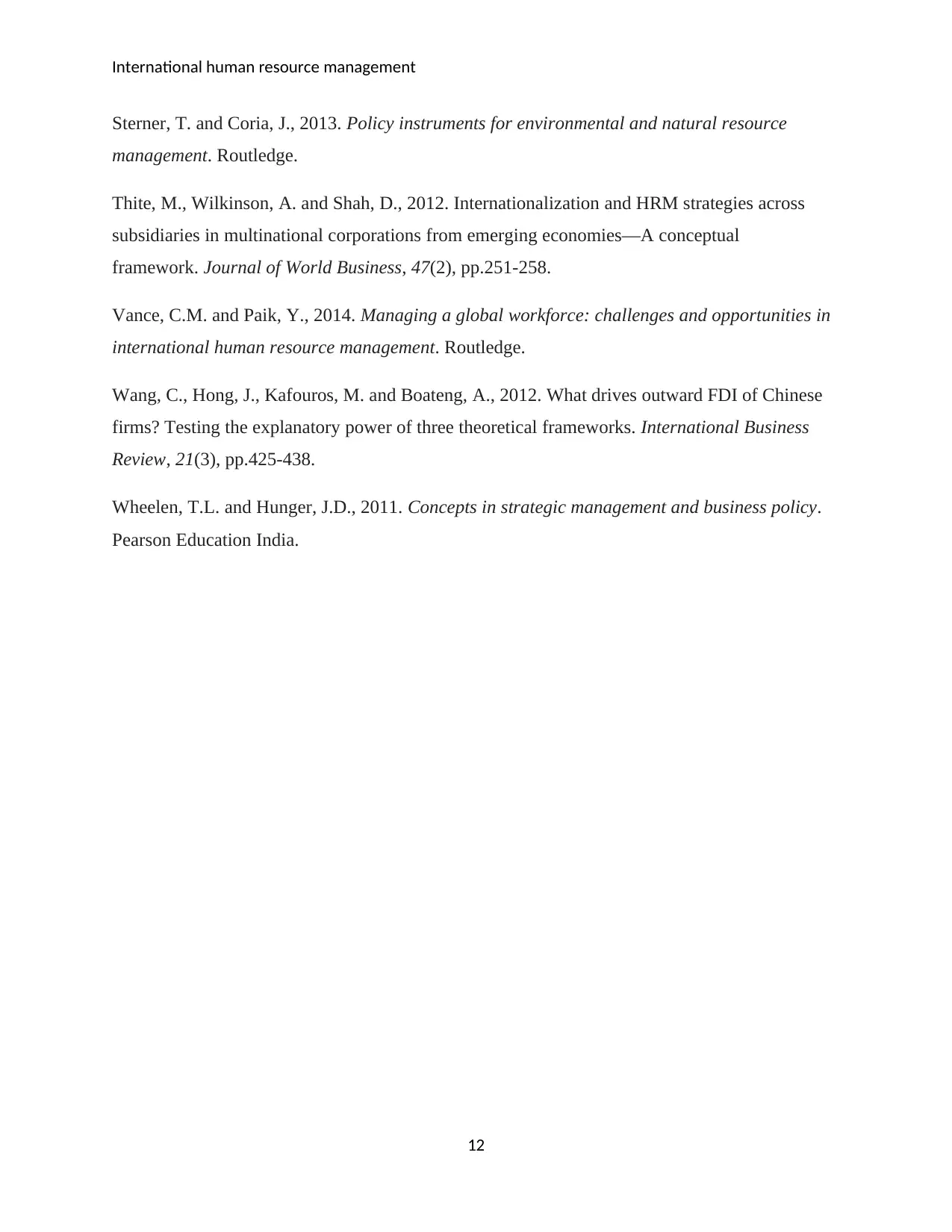
International human resource management
Sterner, T. and Coria, J., 2013. Policy instruments for environmental and natural resource
management. Routledge.
Thite, M., Wilkinson, A. and Shah, D., 2012. Internationalization and HRM strategies across
subsidiaries in multinational corporations from emerging economies—A conceptual
framework. Journal of World Business, 47(2), pp.251-258.
Vance, C.M. and Paik, Y., 2014. Managing a global workforce: challenges and opportunities in
international human resource management. Routledge.
Wang, C., Hong, J., Kafouros, M. and Boateng, A., 2012. What drives outward FDI of Chinese
firms? Testing the explanatory power of three theoretical frameworks. International Business
Review, 21(3), pp.425-438.
Wheelen, T.L. and Hunger, J.D., 2011. Concepts in strategic management and business policy.
Pearson Education India.
12
Sterner, T. and Coria, J., 2013. Policy instruments for environmental and natural resource
management. Routledge.
Thite, M., Wilkinson, A. and Shah, D., 2012. Internationalization and HRM strategies across
subsidiaries in multinational corporations from emerging economies—A conceptual
framework. Journal of World Business, 47(2), pp.251-258.
Vance, C.M. and Paik, Y., 2014. Managing a global workforce: challenges and opportunities in
international human resource management. Routledge.
Wang, C., Hong, J., Kafouros, M. and Boateng, A., 2012. What drives outward FDI of Chinese
firms? Testing the explanatory power of three theoretical frameworks. International Business
Review, 21(3), pp.425-438.
Wheelen, T.L. and Hunger, J.D., 2011. Concepts in strategic management and business policy.
Pearson Education India.
12
⊘ This is a preview!⊘
Do you want full access?
Subscribe today to unlock all pages.

Trusted by 1+ million students worldwide
1 out of 12
Related Documents
Your All-in-One AI-Powered Toolkit for Academic Success.
+13062052269
info@desklib.com
Available 24*7 on WhatsApp / Email
![[object Object]](/_next/static/media/star-bottom.7253800d.svg)
Unlock your academic potential
Copyright © 2020–2025 A2Z Services. All Rights Reserved. Developed and managed by ZUCOL.




